BRITISH ELECTRONICS FIT The aim of this web document is to compare the wartime electronics fit between the British and Canadian built Lancaster bombers.
As often with combat mission equipment, the answers can depend on the specific application or duties of the unit or squadron, and in this case the exact radio fit could depend on the county of manufacture of the aircraft (UK or Canada) Also the requirements of the individual squadron and the duties of the individual aircraft need to be taken into account. Modifications and changes would also take place during the service life of the aircraft as required.
Later in World War II, some bombers carrying out special duties began to carry additional specialized equipment for navigational and similar purposes. The equipment was more complex than that normally carried and a specially trained "Set Operator" was carried to operate it and interpret the results. His equipment was usually referred to as "the gubbins" and he was regarded as a specially intelligent person, a "Gen kiddie".
COMMUNICATIONS
There is one loose end here and that is VHF voice communications. During the research, no evidence could be found that VHF voice capability was fitted to British built Lancasters. Manual AP 2062(F) for the Canadian built Lanc is also devoid of any references to VHF comms. However, a 1945 photo shows a BC-602 remote control box fitted at the radio operators station. That is the control box for the SCR-522 VHF radio. Perhaps it was a case of needing VHF comms by 1945.
NAVIGATION
 |
| A dedicated R1155 receiver for the navigator was not always installed. Some aircraft had it and some didn't . It would depend on the squadron's requirements and the individual aircraft duties. The wireless operator's R1155 receiver was normally provided with a separate DF antenna and cross needle DF indicator, but if a second receiver was installed for the Navigator, then the Wireless Op receiver was not equipped with a DF antenna or cross needle DF indicator and valves V1, V2 and V9 in the R1155 were removed to reduce power consumption. (Photo courtesy Wikimedia.org) |
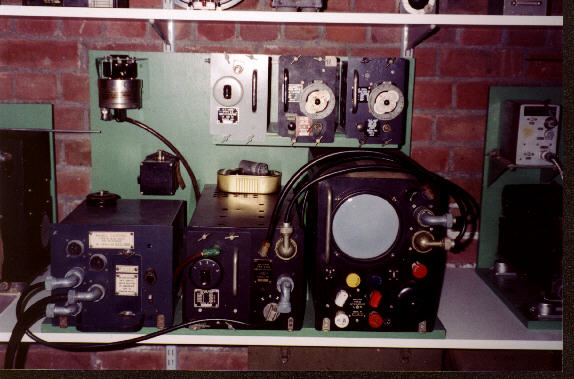 |
| Gee- receiver components. Later on, the navigator's R1155 was replaced with a GEE set. This set measured, on a cathode ray tube, the time delay between signals sent by GEE transmitters located in England. . For the first time, this breakthrough enabled accurate navigation into the western part of Germany. The range of GEE was 300 to 400 mi (483 to 644 km). Select this link for a comprehensive look at the GEE system. (Photo courtesy of "Signals Collection '40-'45" web page). |
| GEE- H. It was similar to Oboe but with the transponder on the ground allowing more aircraft to use the system simultaneously. GEE-H aircraft were usually marked with two horizontal yellow stripes on the fins. |
 |
| Towards the end of the war, the navigator's GEE set was replaced by the 3 GHz H2S radar set. Employing a Plan Position Indicator (PPI) display, it was one of the first airborne, ground scanning, radar systems. Additional info on H2S radar can be found here. (Photo by Norman Groom, Pitstone Museum , UK. Used with permission) |
DEFENCE and COUNTERMEASURES
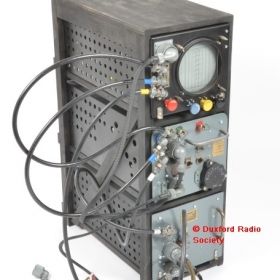 |
| MONICA. Operated at frequencies of around 300 MHz. This was a rearward-looking radar used by the tail gunner to warn of night fighter approaches. Range was from 1.000 yards to 4 miles in a 45 degree arc. However, it could not distinguish between attacking enemy fighters and nearby friendly bombers. Inadvertently, It served as a homing beacon for suitably equipped German night fighters. Once this was realized, after mid-July 1944, MONICA was removed altogether. .(Courtesy Duxford Radio Society) |
 |
| H2S Fishpond. It was an add-on display to H2S that provided additional (aerial) coverage of the underside of the aircraft. Fishpond would display attacking fighters on an auxiliary screen located at the radio operator's position. ( Photo via Wikipedia) |
AIRBORNE CIGAR (ABC)This was only fitted to the Lancasters of 101 Squadron. It used three aerials; two were sticking out of the top of the fuselage and one under the bomb aimer's position. These aircraft carried a German speaking crew member on board and were used to jam radio frequencies being used by German night fighters and feed false information on allied bomber positions to them. Due to the nature of the equipment, the enemy was able to track the aircraft and as a result 101 Squadron suffered the highest casualty rate of any bomber squadron. First fitted from about mid-1943, ABC remained until the end of the war.
BOOZER
A radar detector system of lights mounted on the aircraft's instrument panel. It lit up when the aircraft was being tracked by the low-UHF band Würzburg-Riese ground radar and early model Liechtenstein B/C and C-1 airborne radar. In practice it was found to be more disconcerting than useful, as the lights were often triggered by false alerts in the radar-signal-infested skies over Germany.
IFF
This was a Mkk II IFF , system designator ARI 5000. Te version fitted would also depend on the date in question as the design and installation of the various marks of IFF evolved.
Transponder R3002 (12V), R3082 (Tropical 12V), R3003 (24V), R3083 (tropical 24V)
Control unit type 17, 18
Aerial type 90, 93OBOE
A very accurate navigation system consisting of a receiver/transponder for two radar stations transmitting from widely separated locations in Southern England which, when used together, determined the aircraft's position. The system could only handle one aircraft at a time, and was fitted to a Pathfinder aircraft, usually a fast and manoeuvrable Mosquito which marked the target for the main force rather than a Lancaster.
TINSEL
The code name 'Tinsel' referred to a type of equipment carried by RAF bombers which was used for jamming Luftwaffe night-fighter controller's speech frequencie It consisted of an audio microphone mounted inside one of the bomber's engine nacelles, the output of which fed into the aircraft's standard T1154 radio transmitter. The wireless operator could listen in to the frequencies used by the defending forces and then, when he heard a German transmission, tune his transmitter to the Luftwaffe frequency and transmit the amplified engine noise on the same frequency, thus jamming the enemy transmission.
Although not very effective as a jammer, the noise produced merely acted as background noise to the transmitted speech, Tinsel did have the effect of making the night-fighter crew's job of distinguishing the instructions received from the ground more difficult.
VILLAGE INN. A radar-aimed gun turret fitted to some Lancasters in 1944.
Of later Lancaster variants, only the Canadian built Lancaster Mk .X was manufactured by Victory Aircraft in Malton, Ontario. A total of 430 of this type were built. Canada was the only country outside the UK that built the Lancaster. This Canadian variant differed little from their British built predecessors, except for using Packard-built Merlin engines and American style instrumentation and electronics. Much of the Bendix equipment used on Canadian aircraft during World War II was built under license by Northern Electric in Montreal and clearly labeled on the equipment ID plates. Canada was a long term operator of the Lancaster, utilizing modified aircraft in postwar maritime patrol, search and rescue and photo reconnaissance roles until retirement in 1964.DIAGRAMS
| Figure 1 - Outline View |
| Figure 1A - Equipment At Radio Ops station |
| Figure 1B - Equipment At Navigators station |
| Figure 4- Block Schematic . It shows where the electronics was located in the aircraft. |
| Diagrams provided by Joe Burtinsky. From publication AP 2062(F) dated 1943. |
COMMUNICATIONSThe radio operator's position in the aircraft is at the aft end of the navigator's table facing forward. Most of the radio equipment is mounted in front of the radio operator on or below the navigator's table as shown in figures lA and 1B below. The radio operators station can in several different configurations as depicted in the photos below. Facing the radio operator are two Bendix TA.12C Transmitters mounted one above the other at the right side of the table. (See Fig t 1A) Mounted at the left of these transmitters are two Bendix MT.5 3 loading units for the transmitters, and above them are the 39260 Antenna Relay and a type 3939 Antenna Switch for selecting either the fixed or trailing aerial and for grounding the fixed aerial when not in use.
Mounted behind the transmitters is the main junction box 1 containing circuit breakers for the four main units. Also mounted at the left of the radio operator on the navigator's table are the MR.9B Remote Control for the RA.I0B Receiver, and the 3616B Remote Control for the TA.12C Transmitters. Above the radio operator's head, on the port side of the fuselage is mounted a panel carrying the BC.461 Remote Control unit for the trailing aerial motor, the remote control for the compass receiver, the MR.1 SA remote control and the MN.22A Azimuth Indicator for the D.F. loop, the IN.4A Left - Right Indicator, the radio operator's MI.22A Intercommunication station box and the R.3090 equipment remote control panel. Below the navigator's table (see Fig. 1 B) are mounted the Bendix MP.28BA Power Unit containing the high tension dynamotor and modulator for the transmitters, junction boxes 2 and 3, the Bendix MN.26C Compass Receiver and the Bendix RA.I0DB General Purpose Receiver. The TR.l196 Transmitter Receiver is located above the front spar on the port side of the fuselage and the ARI. 5122 system is mounted just aft of the entrance door on the starboard side of the aircraft.
 |
| In this radio operators position , the BC-348 receiver (bottom)
and ART-13 transmitter (top) are in evidence. BC-348 frequency coverage
is 190 - 500 KHz and 1.5 to 18 MHz. This receiver could only be controlled
locally The vintage of this installation is not known at this time.
The Collins ART-13, an autotune HF transmitter, was the main communications set in this configuration . ART-13 Frequency range: 1.5 to 18 MHz and 200 to 600 KHz .
|
 |
| This is a mockup of a Canadian Lancaster radio operator's position as seen at the Canada Aviation Museum in Ottawa, formerly called the National Aeronautical Collection. Canadian built Lancasters used American made radios and electronics. In evidence is the ART-13 transmitter (top) and BC-348 receiver below. (Photo by Jerry Proc) |
 |
| This Canadian setup from 1945, used
two Bendix TA-12G
tramsnitters . TA-12Cs were fitted in 1943. (Library and Archives
Canada photo)
TA 12 frequency coverage depends on the variant : TA12B 300 - 600 kHz; 3000 - 4800 kHz; 4800 - 6400 kHz;4.37
- 7.0 MHz .
The TA-12G has similar coverage to the TA-12B except for the 4th channel. The 'G' model was the last version and had some minor circuitry changes which were done by Northern Electric in Montreal This change was likely unique to the RCAF. Interestingly, the 'C' model goes all the way up to 12.0 MHz but the companion RA-10 receiver did not go that high in its frequency coverage. |
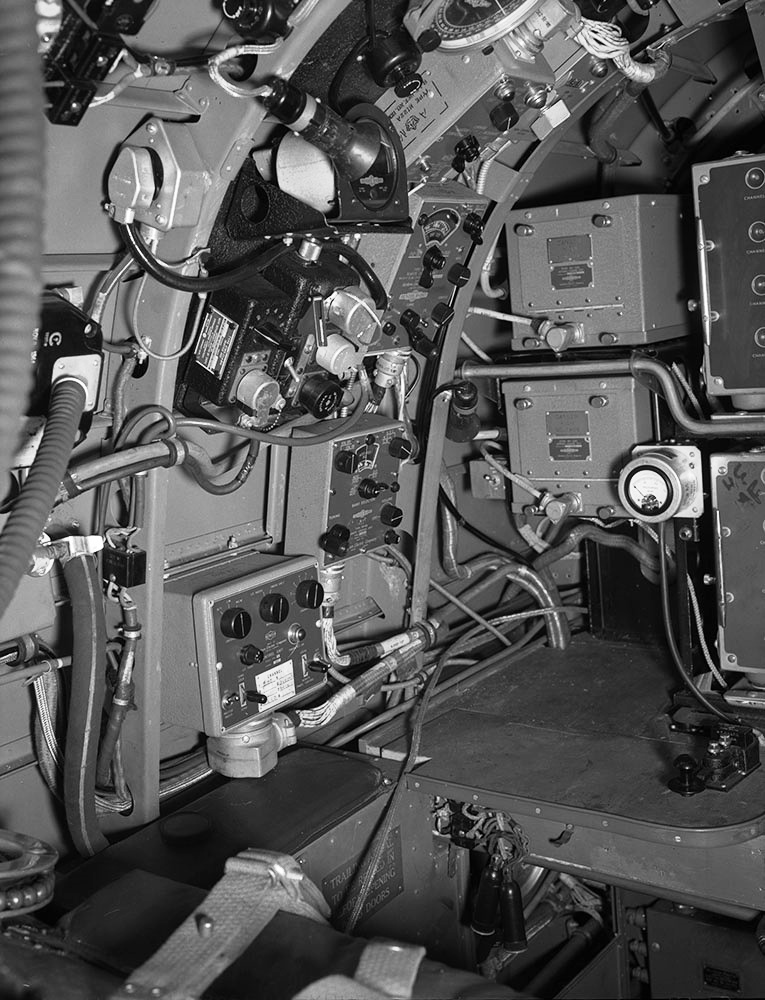 |
| To the left, at the middle and bottom are remote control boxes for the Bendix RA-10 receiver and the MN-26 DF receiver. On the table is the standard Bendix MT11-B telegraph key, adopted by the military (US and Canada) and was built in great numbers. (Library and Archives Canada photo) |
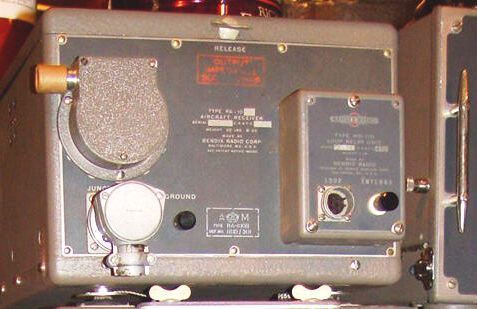 |
| RA10DB receiver. The RA10DB receiver
band coverage is as follows -
Band 1: 150-400 kHz 2: 400-1100 kHz 3: 2.0-5.0 MHz 4: 5.0-10.MHz (Photo courtesy AAF radio) |
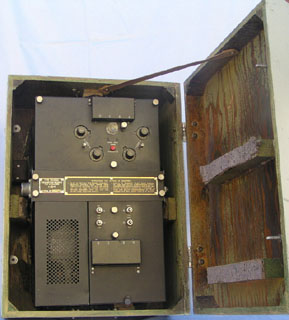 |
| TR-1196., a four channel HF transmitter-receiver ,circa 1943, was t a four channel HF transmitter which operated in the 4.3 to 6.7 MHz band. It was produced in 4 different versions, namely, TR-1196/A/B/C. Units were made in 12 and 24 volt versions It is believed to have the same functionality as the British TR9F set. (Photo courtesy Kurrajong Radio Museum, Australia) |
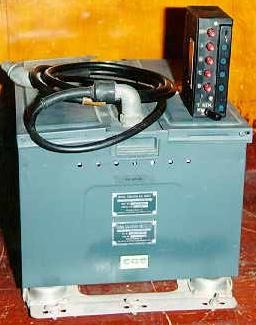 |
| SCR-522 (1945). The SCR-522 was a voice only, transmitter/receiver operating in the 100 to 156 Mc band with a power output of 8 to 9 watts. It was re-design of the British TR 1133 VHF set in order that it could be manufactured with American tooling. Operation was provided on any one of four crystal controlled channels. The BC602 remote control box was used with the SCR-522 VHF radio which was located remotely to the radio ops position, Here the BC602 sits atop the radio and is also evident in the 1945 photo of the radio ops position below. It is labelled VHF. Since the SCR522 could only operate with one remote control, the radio op worked VHF communications. (Photo by Jerry Proc) |
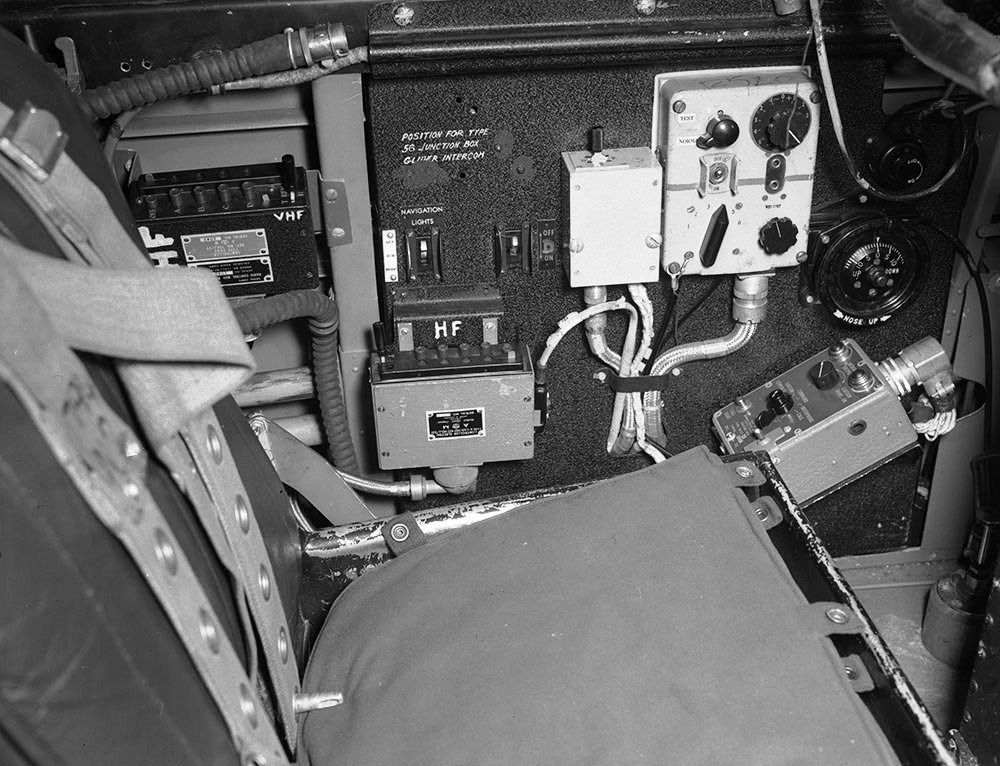 |
| This photo shows the placement of the BC-602 remote control box in 1945 . It is not known if the aircraft was fitted with VHF capability in 1943. The box labelled 'HF' is the remote control for the TR1196 HF transmitter/receiver. (Library and Archives Canada photo). |
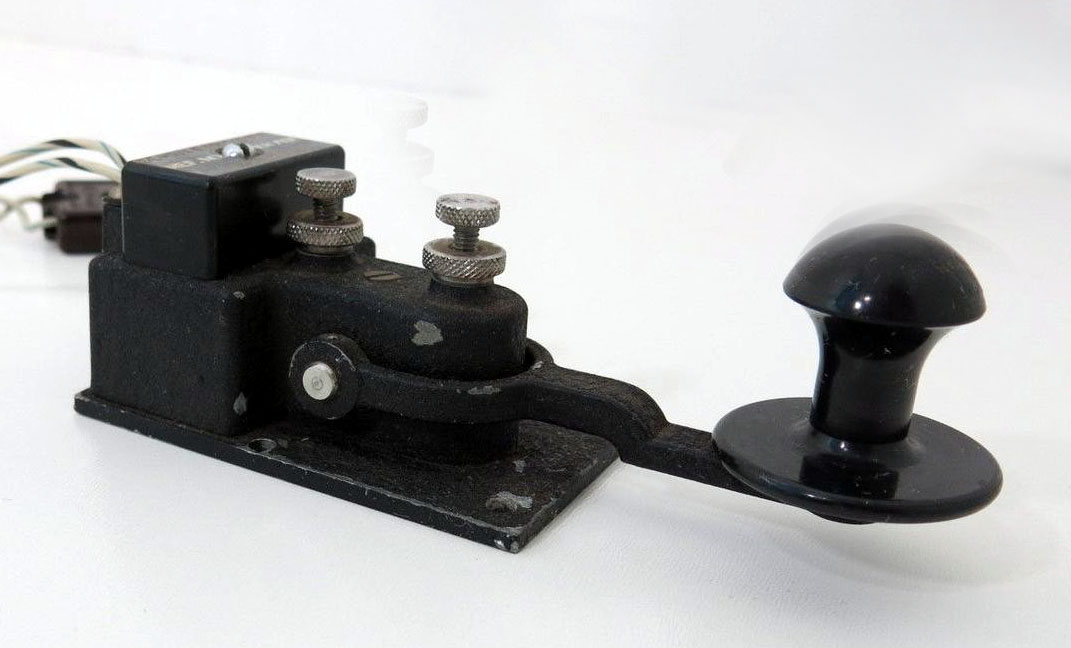 |
| The MT11B key. was a Bendix design that was adopted by the US Navy before (or in the early days of) World War II. The RAF "bathtub" key as well as the Bendix MT-11 were referred to as "flameproof" keys. That is, the contacts were totally enclosed, a possibly important factor when you were limping home in a shot up aircraft that might be venting fuel vapour into the interior of the aircraft. This design was also copied and produced by manufacturers other Bendix. (Photo via WorthPoint.com) |
NAVIGATION
This installation is mounted at the forward end of the navigator's table behind the pilot's seat . The installation consists of the ARI.5083 navigator's radio equipment with the control unit for the alternators mounted on the floor directly beneath it. Circuit breakers for the IFF equipment, the detonator system, the ARI.5083 equipment and the ARI.5122 equipment are mounted on the navigator's panel, also the press-to-test push button for the ARI.5122 equipment. On the right-hand side of the navigator's panel are two sets of switches, one set supplying A.C. and D.C. current to the ARI.5083 installation and the second set supplying the same to the ARI.5122 installation.
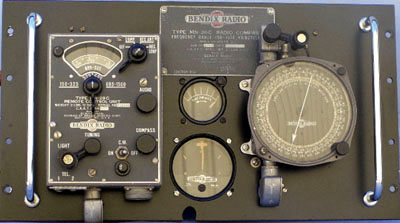 |
The MN26-x is an airborne direction finder
receiver. There were at least eleven different models produced with
the MN 26C being the largest of the variants. It tunes 100 - 1500 kHz in
3 bands. The input voltage for this model is 28 VDC at 5 amps peak.
The MN-26K was unique to the RCAF.
The receiver itself was located remotely in the aircraft and operated by remote control so as to save cockpit space. For a tuning meter the MR57A is used and the IN4A for left/right homing. The D/F loop (MN20 or MN24) was located either above or below the aircraft and was hand rotated using Bowden drive through an MN22A or MN52A control head. (Photo courtesy Kurrajong Radio Museum, Australia) |
 |
Receiver ARI 5083 was the GEE MK 2 receiver used for navigation when the aircraft was in the UK. and in rage of the GEE transmitters. Click on thumbnail to see the system interconnect. A complete description of the GEE Mk2 can be found here. (Image courtesy Blunham.com) |
 |
R1125 Marker Beacon Receiver: In the Figure
1 Outline View drawing, reference is made to an SBA (Standard Blind Approach)
Marker Receiver R1125 which connects with a dipole located beneath the
fuselage around the upper/rear gunners position. This was also called Beam
Approach receiving equipment, airborne. It provided a correct
approach for a marker beacon signal. It was remotely controlled.
and used a retractable main aerial 7 ft. 6 in. dipole in length.
Marker beacon receivers R.1125 and R1125A used MCW and operated in
the 38 MHz band,. (Photo courtesy https://www.qsl.net/pe1ng)
|
| Photo not available at this time. | PPI RADAR - It is not known if a PPI radar like the H2S type was fitted to Canadian Lancs on-build and later in WWII. Perhaps it was fitted once the aircraft was delivered to the RAF? Can anyone confirm? |
INTERCOMMUNICATIONComplete intercommunication for the crew was provided by the use of a Bendix MI.22A station box at each crew position . All staion boxes were connected to an interphone amplifier. The crew would plug in their headphones and mics into the station box. MI.22 provided the ability to listen or talk on liaison or command transmitters and receivers, and to listen to the compass receiver. By means of a switch normally locked in an inoperative position it was also possible to put either the liaison or command transmitter on the air. Station boxes are provided at the following positions:-
Bomb Aimer - Port side of the fuselage in nose.
Front Gunner - In front gun turret.
Pilot - On pilot's auxiliary panel at port side of pilot.
Flight Engineer- Below the starboard cockpit rail, just aft of main instrument panel.
Navigator - At steel tube supporting navigator's table on left side of navigator.
Radio Operator - Mounted to panel on port side of fuselage above the operator's head.
Rest Station - On the port side of the fuselage at former 10.
Mid-Lower Gun Turret - On the port side of the fuselage at former 26.
Mid-Upper Gun Turret - In turret.
First Aid Station - Mounted on starboard side of fuselage just aft of former 35.The interphone amplifier is shown as RCAF part number 110U/36 on the navigators station drawing and that's where the unit was mounted. The real part designator is 3611B from the Block Schematic drawing. It is a two-stage, high gain amplifier which provides inter phone facilities for all crew members. It also supports the use of carbon or dynamic microphones. Output power is 3 watts. Looking for a photo of the 3611B.
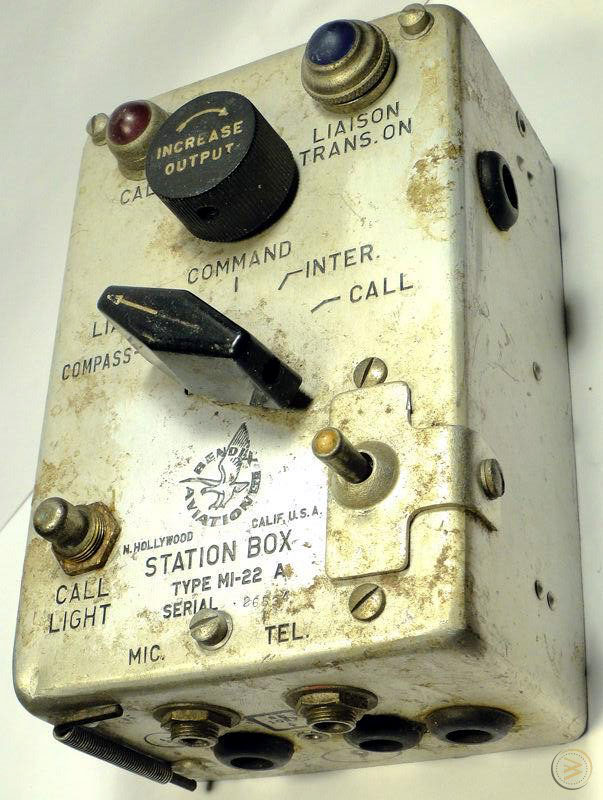 |
| ML-22 station box (Image courtesy WorthPoint.com) |
DEFENCE and COUNTERMEASURES* MONICA Mk 1 (1943). The ARI 5122 system used an R3136 receiver, a T3135 transmitter and a type 116 indicator.
* IFF Mk II - Reference is made on the 1943 Figure 1 Outline drawing to R3090/ABK. A Google search on ABK reveals that this is an IFF Mk II system Another co-ordinate on the drawing is labelled R3003 aerial. Unable to find any detailed info on the R3003 or R3090 devices.
The IFF MK II system was designed to allow switching between any one of 6 different coded responses, usually specified for various types of mission. However, in practice it proved difficult to distinguish one echo from another so generally only position 1 (or A) was used, whilst the longest, widest response position was used universally as a distress signal.
In order to respond to the growing number of raiders in service the aircraft or ship often had to carry multiple IFF units. . The military services recognized that with the proliferation of radar and other equipment there was a need for a distinct frequency band for IFF with a common equipment specification. MK II IFF operated in the 157 to 187 MHz band.
* OTHER EQUIPMENT
It is not known at this time if Canadian built Lamcs were fitted with any British systems once they arrived in the UK. Other extracts from AP 2062(F) include the following:
* Power Supply (1943)
The direct current power supply for the radio equipment is drawn from the main electrical panel supplied by the batteries . (See Fig 1 drawing ) One service from the panel supplies the Bendix and TR.1196 equipment, another supplies the trailing aerial reel motor and a third supplies the detonator system from the navigator's panel, the IFF system, the AR1.5083 (GEE MkII), the ARI. 5122 (Monica) systems and the alternator fields. Mounted on each of the outboard engines are alternating current generators connected to a junction bracket on the port side of the fuselage forward of the navigator'S panel. By means of switches on the navigator's panel, alternating current may be fed to either or both ARI.5083 and ARI.5122 systems.
* Pilot's Equipment (1943)
The pilot's auxiliary panel mounted below the cockpit rail on the port side of the cockpit just aft of the main instrument panel carries the remote controls for the pilot's radio equipment. The remote control for the TR.1196 , the remote control for the Blind Approach system , the pilot's station box and the IFF unit control switch are mounted on this panel. The panel also contains leads for connecting a glider intercommunication circuit if required. The Blind Approach mixer switch enables the pilot to receive Blind Approach signals only, or intercommunication, liaison and command signals paired with Blind Approach by means of the MN.22A unit.
* Aerials (1943)
Twelve aerial systems are provided for the radio equipment (see Fig. 1). A trailing aerial remote controlled motor driven reel is fitted at the radio operator's station on the port side of the aircraft. A general purpose fixed aerial is fitted on the starboard side of the aircraft running from the pilot's canopy to the top of the starboard fin. A corresponding aerial is fitted on the port side of the aircraft except that this aerial is divided into two sections, the front section serving as a sense antenna for the D.F. Compass receiver and the rear section serving as an aerial for the TR.1196 unit. Mounted to the top of the fuselage inside the rear canopy is a remote controlled loop antenna for the D.F. Compass.
Aft of the canopy and mounted to the top of the fuselage is a whip aerial serving the ARI.5083 unit (GEE) . At former 18 just forward of the mid-upper turret is mounted another whip aerial serving as the beam receiving aerial for the Blind Approach units. Two aerials leading from just aft of the mid-upper turret to the outboard ends of the port and starboard's tail planes serve the R.3003 unit. Mounted to the starboard underside of the fuselage opposite of the main entrance door is the dipole aerial for the Blind Approach and on the port side of the aircraft under the main entrance door the R.3090 whip aerial is mounted. Projecting from the aft end of the aircraft is the aerial for the ARI. 5122 unit.
* Detonator Circuit (1943)
The detonator circuit is connected to the ARI.5083 Indicator Unit and the R.3090-R.3003 Receiver Unit. This circuit it can be operated by push buttons on the navigator's panel, on the table at the radio operator's station, and on the right-hand side of the pilot's instrument panel. A crash switch mounted on the starboard side of former 4 in the fuselage nose, also controls the detonator circuits provided the isolating switch on the navigator's panel is turned to LIVE.
IN SUMMARY:
The Canadian-built Lancasters had a different radio fit than the aircraft built in England. The basic setup was:
British - One R1155 receiver and one T1154 transmitter were installed at the radio operator's position.
Canadian - two Bendix TA-12 transmitters, one Bendix RA-12 receiver and one Bendix MN-26 radio compass receiver at the radio ops position.Rumour has it that when Canadian Lancasters reached England, all the Bendix equipment was removed and replaced with the R1155/T1154 configuration.
.
Credits and References:1) https://www.crash40-45.nl/wp-content/uploads/2018/03/Crash-Lancaster-Transceiver-description.pdf
2) http://jproc.ca/hyperbolic/gee.html
3) http://jproc.ca/rrp/rrp3/lanc_h2s.html
4) https://en.wikipedia.org/wiki/H2S_(radar
5) Duxfordd RAdio Society http://www.duxfordradiosociety.org/equiphist/r1155/t1154-r1155-V4-jan2015.pdf?LMCL=VIjFue
6) TR9 https://www.americanradiohistory.com/Archive-Practical/Wireless/50s/PW-1951-05.pdf
7) https://www.historicflyingclothing.com/en-GB//r-a-f-type-f-bath-tub-morse-key---boxed/prod_14083#.XZNgsKhKhzo
8) https://en.wikipedia.org/wiki/Avro_Lancaster#Radio,_radar_and_countermeasures_equipment
9) https://www.skytamer.com/Avro_683_Lancaster_B.Mk.X.html
10) https://en.wikipedia.org/wiki/RAF_Bomber_Command_aircrew_of_World_War_II
11) https://upload.wikimedia.org/wikipedia/commons/9/92/R1155_receiver%2C_with_DF_indicator%2C_
and_T1154L_transmitter%2C_British_World_War_II_radio_equipment_-_Collings_Foundation_-_Massachusetts_-_DSC07102.jpg
12) Joe Burtinsky < jburtinsky(at) 295.ca>
13) Canadian Lanc drawings from publication AP 2062(F) was published in 1943
14) Tom Brent <navyradiocom(at)gmail.com>
15) Kurrajong Radio Museum, Australia https://vk2bv.org/archive/museum/index.htm
16) Monica https://www.qsl.net/pe1ngz/airforce/airforce-raf/raf-homing&warning.html#Monica
17) RA10DB https://aafradio.org/flightdeck/navigation.htm
18) GEE Mk 2 https://www.blunham.com/Radar/SignalsMuseum/PDFs/GeeAirborne.pdf
19) IFF Mk III https://www.qsl.net/vk2dym/radio/iff.htm
20) IFF https://www.qsl.net/vk2dym/radio/iff.htm
21) SBA R1125 https://www.qsl.net/pe1ngz/airforce/airforce-raf/raf-comm-receivers.html
22) RAF Publication AP2062
23) Richard Howes <duxfordradio(at)gmail.com>
24)ARI 5000 IFF http://air-ministry.uk/ari.htm
25) TB Orlowski <tborlowski(at)hotmail.com>
Dec 10/20